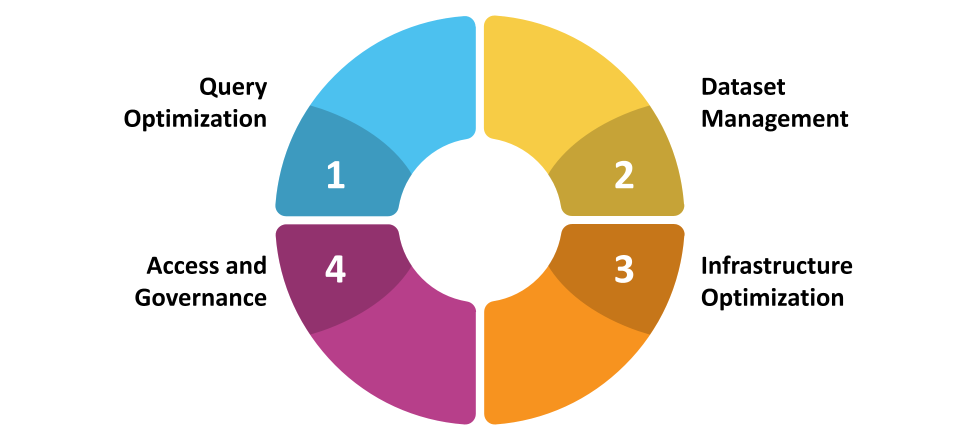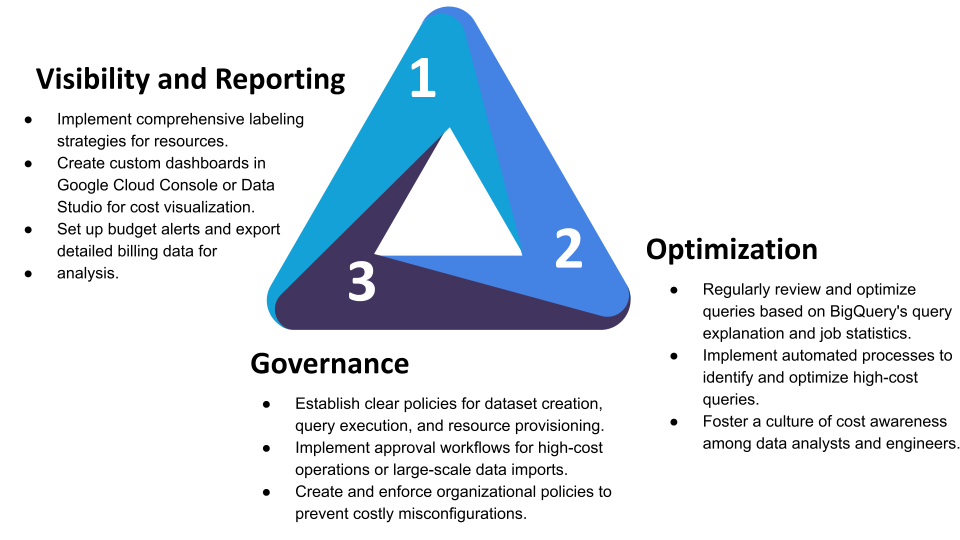Mastering BigQuery Cost Management and FinOps: A Comprehensive Checklist
Effective cost management becomes crucial as organizations increasingly rely on Google BigQuery for their data warehousing and analytics needs. This checklist delves into the intricacies of cost management and FinOps for BigQuery, exploring strategies to inform, govern, and optimize usage while taking a holistic approach that considers queries, datasets, infrastructure, and more.
While this checklist is comprehensive and very impactful when implemented fully, it can also be overwhelming to implement with limited staffing and resources. AI-driven insights and automation can solve this problem and are also explored at the bottom of this guide.
Understanding Cost Management for BigQuery
BigQuery’s pricing model is primarily based on data storage and query processing. While this model offers flexibility, it also requires careful management to ensure costs align with business value. Effective cost management for BigQuery is about more than reducing expenses—it’s also about optimizing spend, ensuring efficient resource utilization, and aligning costs with business outcomes. This comprehensive approach falls under the umbrella of FinOps (Financial Operations).
The Holistic Approach: Key Areas to Consider

1. Query Optimization
Are queries optimized? Efficient queries are fundamental to cost-effective BigQuery usage:
Query Structure: Write efficient SQL queries that minimize data scanned.
Partitioning and Clustering: Implement appropriate table partitioning and clustering strategies to reduce query costs.
Materialized Views: Use materialized views for frequently accessed or complex query results.
Query Caching: Leverage BigQuery’s query cache to avoid redundant processing.
2. Dataset Management
Are datasets managed correctly? Proper dataset management is crucial for controlling costs:
Data Lifecycle Management: Implement policies for data retention and expiration to manage storage costs.
Table Expiration: Set up automatic table expiration for temporary or test datasets.
Data Compression: Use appropriate compression methods to reduce storage costs.
Data Skew: Address data skew issues to prevent performance bottlenecks and unnecessary resource consumption.
3. Infrastructure Optimization
Is infrastructure optimized? While BigQuery is a managed service, there are still infrastructure considerations:
Slot Reservations: Evaluate and optimize slot reservations for predictable workloads.
Flat-Rate Pricing: Consider flat-rate pricing for high-volume, consistent usage patterns.
Multi-Region Setup: Balance data residency requirements with cost implications of multi-region setups.
4. Access and Governance
Are the right policies and governance in place? Proper access controls and governance are essential for cost management:
IAM Roles: Implement least privilege access using Google Cloud IAM roles.
Resource Hierarchies: Utilize resource hierarchies (organizations, folders, projects) for effective cost allocation.
VPC Service Controls: Implement VPC Service Controls to manage data access and potential egress costs.
Implementing FinOps Practices
To master cost management for BiqQuery, consider these FinOps practices:

1. Visibility and Reporting
Implement comprehensive labeling strategies for resources.
Create custom dashboards in Google Cloud Console or Data Studio for cost visualization.
Set up budget alerts and export detailed billing data for analysis.
2. Optimization
Regularly review and optimize queries based on BigQuery’s query explanation and job statistics.
Implement automated processes to identify and optimize high-cost queries.
Foster a culture of cost awareness among data analysts and engineers.
3. Governance
Establish clear policies for dataset creation, query execution, and resource provisioning.
Implement approval workflows for high-cost operations or large-scale data imports.
Create and enforce organizational policies to prevent costly misconfigurations.
Setting Up Guardrails
Implementing guardrails is crucial to prevent unexpected costs:
Query Limits: Set daily query limit quotas at the project or user level.
Cost Controls: Implement custom cost controls using Cloud Functions and the BigQuery API.
Data Access Controls: Use column-level and row-level security to restrict access to sensitive or high-volume data.
Budgets and Alerts: Set up project-level budgets and alerts in Google Cloud Console.
The Need for Automated Observability and FinOps Solutions
Given the scale and complexity of modern data operations, automated solutions can significantly enhance cost management efforts. Automated observability and FinOps solutions can provide the following:
Real-time cost visibility across your entire BigQuery environment.
Automated recommendations for query optimization and cost reduction.
Anomaly detection to quickly identify unusual spending patterns.
Predictive analytics to forecast future costs and resource needs.
These solutions can offer insights that would be difficult or impossible to obtain manually, helping you make data-driven decisions about your BigQuery usage and costs.
BigQuery-Specific Cost Optimization Techniques
Avoid SELECT: Instead, specify only the columns you need to reduce data processed.
Use Approximate Aggregation Functions: For large-scale aggregations where precision isn’t critical, use approximate functions like APPROX_COUNT_DISTINCT().
Optimize JOIN Operations: Ensure the larger table is on the left side of the JOIN to potentially reduce shuffle and processing time.
Leverage BigQuery ML: Use BigQuery ML for in-database machine learning to avoid data movement costs.
Use Scripting: Utilize BigQuery scripting to perform complex operations without multiple query executions.
Conclusion
Effective BigQuery cost management and FinOps require a holistic approach that considers all aspects of your data operations. By optimizing queries, managing datasets efficiently, leveraging appropriate pricing models, and implementing robust FinOps practices, you can ensure that your BigQuery investment delivers maximum value to your organization.
Remember, the goal isn’t just to reduce costs, but to optimize spend and align it with business objectives. With the right strategies and tools in place, you can transform cost management from a challenge into a competitive advantage, enabling your organization to make the most of BigQuery’s powerful capabilities while maintaining control over expenses.
To learn more about how Unravel can help with BigQuery cost management, request a health check report, view a self-guided product tour, or request a demo.


